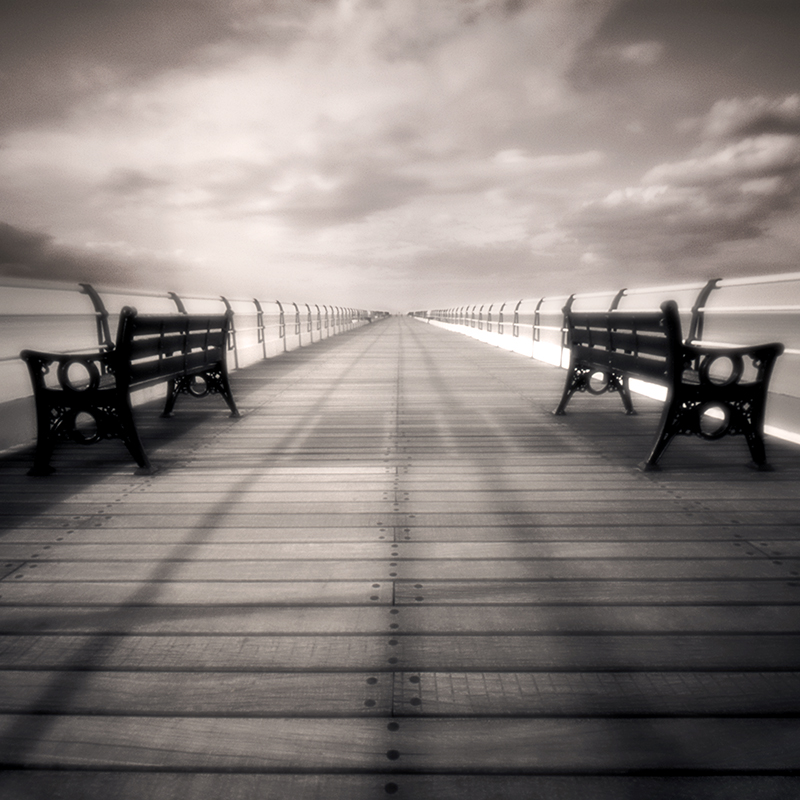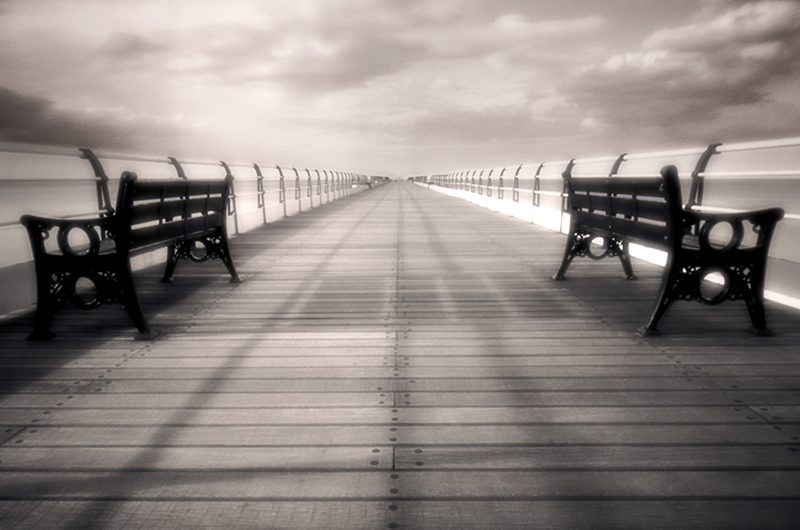

“Photographs – at least good ones – are always about ideas; without ideas photographs are merely images. For an image to be idealess is as emasculating as a paragraph without a thought”. (Brooks Jensen in ‘Letting Go of the Camera’)
Two Seats – Saltburn, England (Zero Image Pinhole Camera)
Whenever I’m running photographic workshops I’m constantly encouraging the participants to consider why they are taking a photograph – what is it that’s attracting them to a particular subject and importantly, what is the idea, the concept behind it? I believe that there has to be a reason to take a photograph.
What I particularly urge photographers to do is to photograph what they feel as much, if not more, than what they see. At the same time I’m quick to acknowledge that this is one of the biggest challenges any photographer faces. It’s easy to get lured into taking a photograph just for it’s visual appeal. And that’s OK but I’ve found that the images that have the greatest lasting impact on the viewer are the ones that communicate some form of emotion; photographs that capture what the photographer felt at the time of firing the shutter, not just what they saw.
An important first step is for the photographer to slow down and before taking the shot to ask themselves ‘why am I taking this photograph?’. Being clear about the attraction of a particular scene is the foundation for all other decisions about lens choice, composition, focal point, aperture selection and so on. This requires a more in-depth analysis on behalf of the photographer than ‘I just like it’ – what is it specifically that appeals (the light, textures, patterns, tonal contrasts etc etc)?
Whenever I’m answering this question for myself I add a supplementary prompt – how does this scene/subject make me feel? If the response is a strong one then I know I stand a chance of producing a powerful image that might just convey a mood. Whereas I’ve learnt that an apathetic response will almost certainly lead to me producing a superficial image that I’ll soon grow tired of. And it’s the answer to this question that influences the techniques & approaches that I adopt.
I believe that the subject should always be the driver. So rather than impose a mood on the subject I try to respond to it and how it makes me feel at a particular point in time. I work hard to avoid having any preconceptions about what I might find or how I might react so that my images reflect the mood created by the scene before me. This requires me to clear my mind of any emotions or stresses that I may be carrying with me – which is why I see the photographic process as a form of meditation.
However I’m not naïve – I know that the camera looks both ways; a photograph says as much about the photographer as the subject. I just try to remove as much of my ‘personal baggage’ as I can. But undoubtedly my own mood comes into play and the photographs I produce are always the result of a dialogue between me and the landscape. I just try to ensure that the landscape has the loudest voice!
And my choice of technique is always an attempt to convey the outcome of that dialogue. So for example a melancholy mood might result in a darker, more forbidding photograph whereas a sense of joy would produce an image that is light & airy. In every case though, my choice of technique is determined by my interaction with the landscape. I firmly believe that to try and apply the same technique to every photograph is not only unrealistic but is the path to shallow art making where the resulting image says more about the technique and the photographers obsessions than the subject.
Of course the successful matching of subject & technique is not easy and is most usually the result of extensive trial and error – for experience and experimentation are the keys to success. By taking some of my images as examples and describing for each what I was trying to convey and my choice of technique I aim to provide an insight into my approach in the hope that readers can benefit from my own efforts to communicate emotional as well as visual messages.
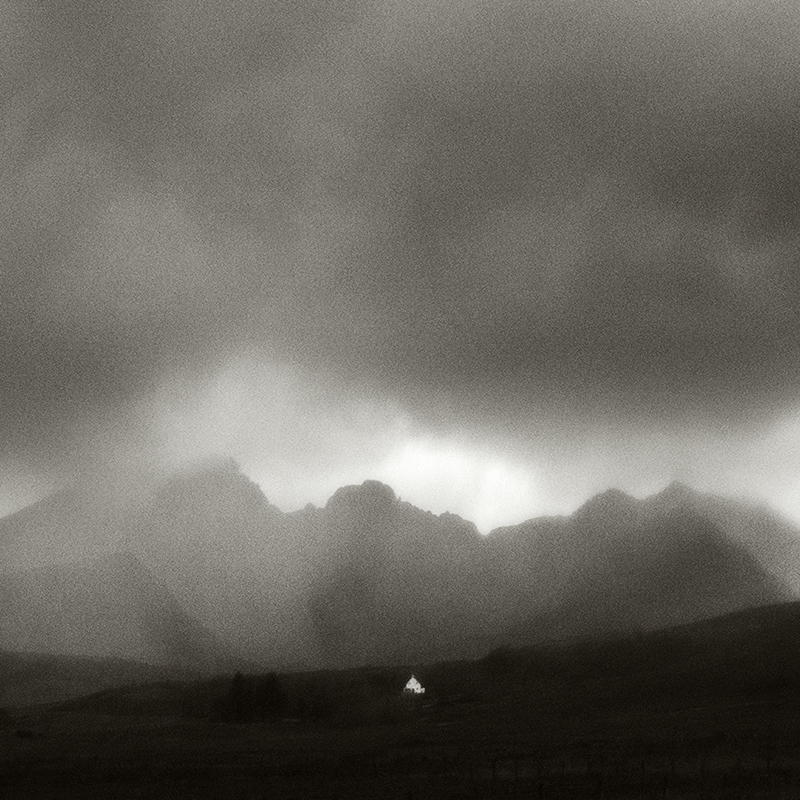
‘The White Cottage’ (The Isle of Skye, Scotland)
Canon G9
This was taken at the end of a wet & windy day on the Isle of Skye, Scotland as the light was beginning to fade. As I drove along the road I spotted a lone white cottage in the gloom. It was dwarfed by a threatening sky and the Cuillin hills directly behind. It felt isolated, overshadowed and threatened by the elements around it but somehow it seemed to offer a sanctuary; a haven providing shelter and protection.
I tried to capture these feelings by placing the cottage so it was very small in the frame. I hoped this would emphasise its isolation, its vulnerability. And by printing the rest of the photograph relatively dark and keeping the cottage as a bright element surrounded by dark tones I tried to visually represent the cottage as a beacon; like a lighthouse at a harbour entrance it hints at safety and the possibility of respite from the elements.
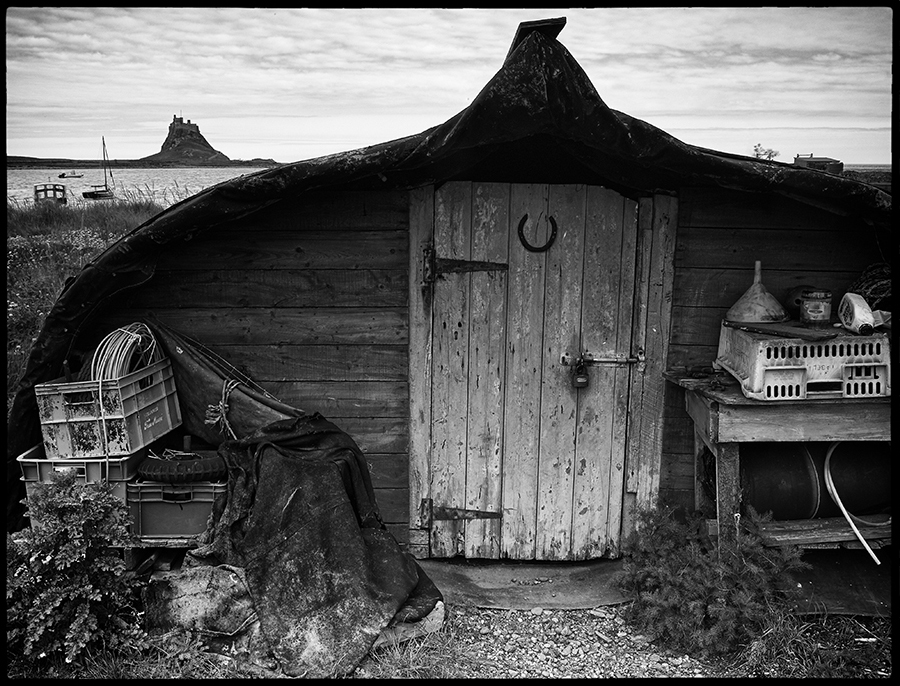
‘The Sorting Hat’ (Lindisfarne, Northumberland, England)
Leica M9 and 28mm Elmarit lens
This shot was taken at Lindisfarne (an island off the Northumberland coast) where upturned boats have been converted into sheds. I’ve always been attracted to this particular little shed surrounded by all the clutter and paraphernalia of a working fisherman. But in spite of looking at it every time I had visited either the light hadn’t been right or I hadn’t been able to find a shot that was visually strong enough.
However on this particular occasion the lighting suited the subject and I spotted an element I hadn’t noticed before. And it was this element that provided the final piece in the jigsaw – the thing that brought the shot together. It appealed to my sense of humour and made me smile – so it generated some form of emotional response and was therefore worth taking the trouble to set the camera up and take a shot. I believe any emotional reaction is important – it doesn’t have to be extreme to be worth a photograph.
And the element I’m referring to, that made me smile, is the top of the shed – I thought it resembled the sorting hat (from the Harry Potter films). It also reflected the shape of the castle beyond and therefore provided a compositional link between the elements in the frame.
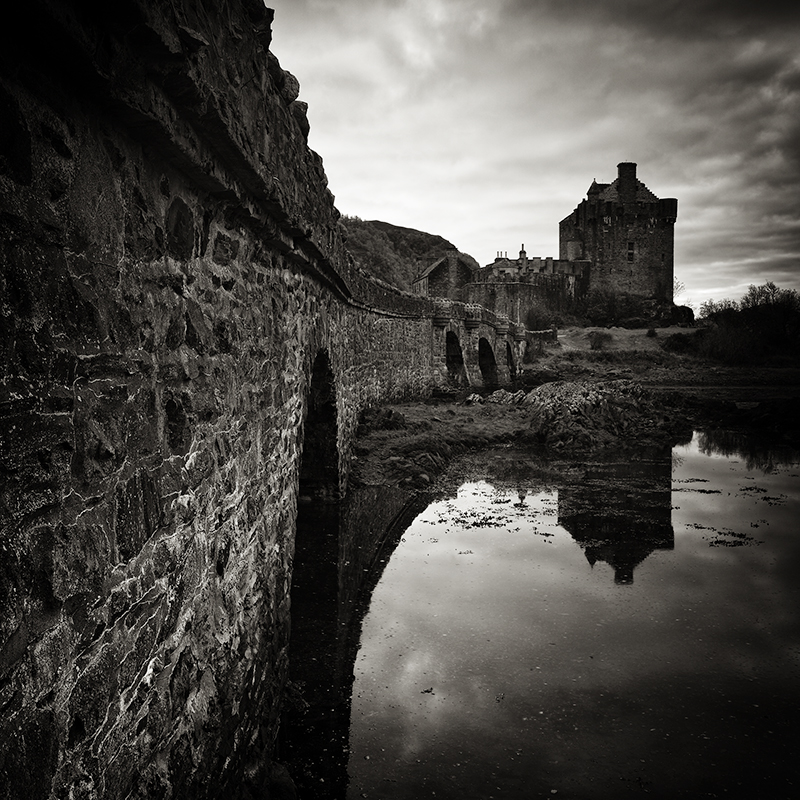
‘The Old Pretender’ (Eilean Donan castle, Scotland)
Alpa TC, 36mm Schneider lens, Phase One P20+
This is a much photographed castle in Scotland – and rightly so, it’s an archetypal Scottish castle situated at the edge of a photogenic loch. Images of it taken in bright sunshine with blue sky and fluffy white clouds behind have appeared on biscuit tins, chocolate boxes and in ‘Beautiful Britain’ type books & calendars. But those images do nothing for me and I think they really fail to capture the drama and the history of the location. Without boring you with all the details, the first fortified structure was built here in the 13 th century as a defence against marauding Vikings and it then saw 500 years punctuated by turmoil and battle.
And I wanted to capture the sense of this history in my photograph: –
– the moody sky helped me to create the right sort of atmosphere (a blue sky was definitely not required!); and
– I’ve printed it in a way that I hope captures that dark and foreboding feel I was looking for.
Compositionally I wanted to concentrate the viewer’s attention on the castle so I kept the image structure as simple as possible, using line and shape to lead to the focal point.
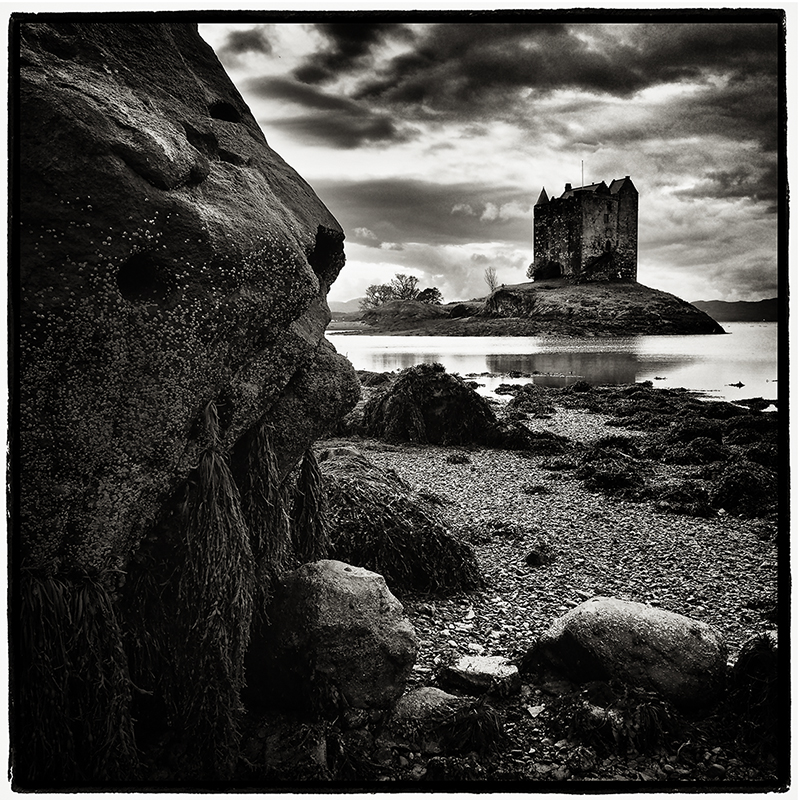
‘Dracula’s Castle’ (Castle Stalker, Scotland)
Olympus OMD and 12-50mm lens
Another shot of a Scottish castle – this time of Castle Stalker on Loch Linnhe.
There’s something about Scottish castles that makes me think of Dracula films – in the right weather conditions evil and malicious intent seems to ooze from their walls. The lighting was perfect and the sky was co-operating to enhance the mood I was after so I searched hard for a composition that reflected the mood of this ominous looking castle. When I found the large rock in the foreground and spotted the gargoyle like face on its surface I knew that I had my shot.
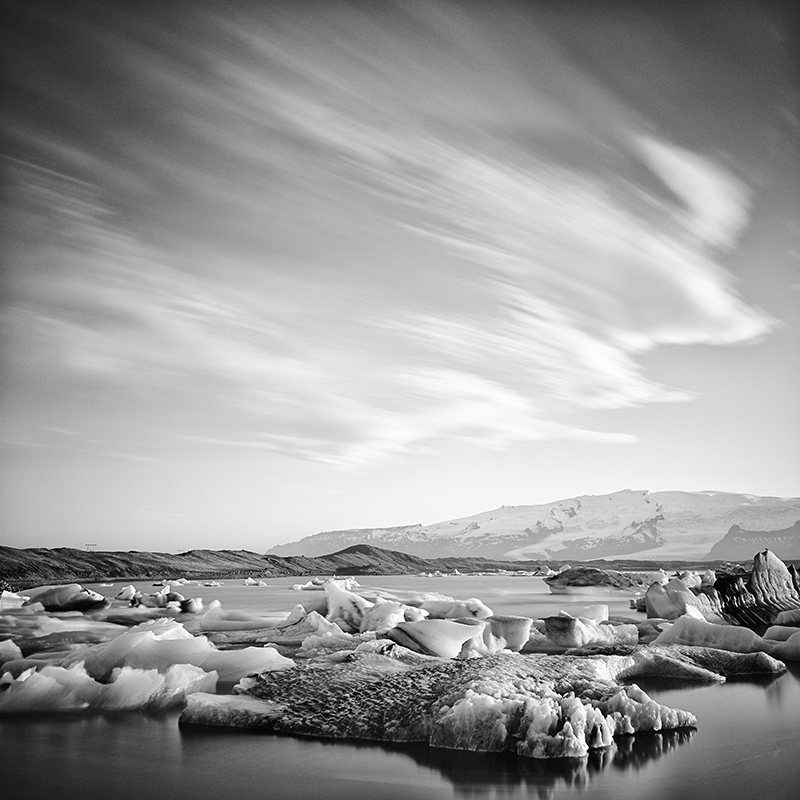
‘Dolphins’ (Jokulsarlon, Iceland)
Alpa TC, 36mm Schneider lens, Phase One P20+
I think this has to be the most magical place I’ve ever been to in my life – the glacial lagoon at Jokulsarlon in Iceland. This was taken on my first visit there last year whilst running a PODAS workshop for Phase One. I was overwhelmed by emotion when I first stood on the shore of the lagoon – as icebergs floated past and seals swam only feet away from me. I wanted to contrast the sense of peace & stillness I felt with the notion of movement that is characteristic of this landscape. It’s constantly moving and changing; no two days are the same. I used a 10 stop ND filter to give me a long exposure and that allowed me to record the movement of the clouds. It’s also captured some movement in the ice – hinting at the constant shifting of the icebergs as they break off from the glacier and start their journey into the ocean.
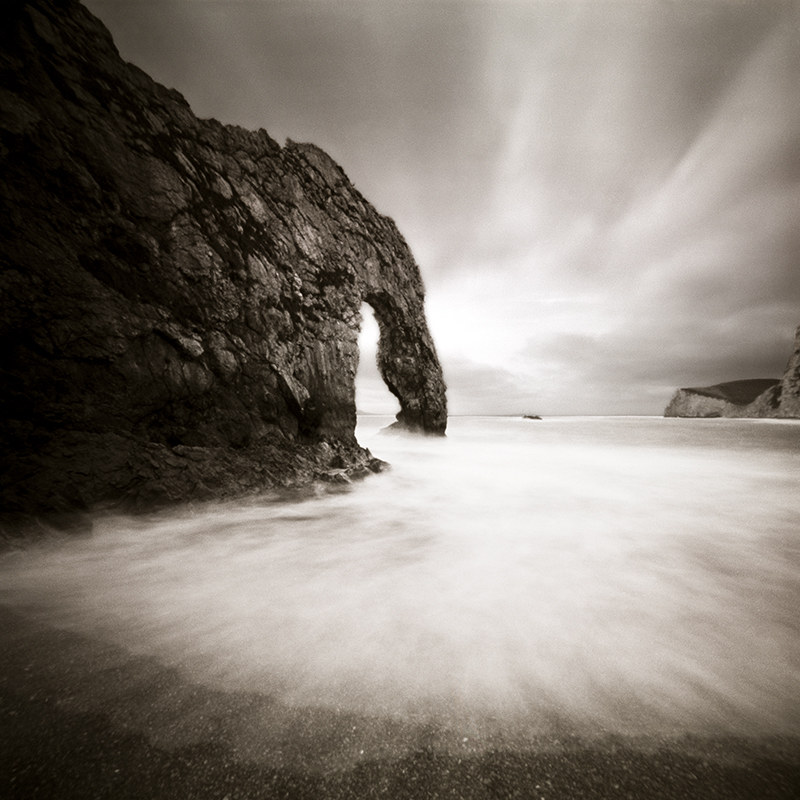
‘Time & Motion’ (Durdle Door, Dorset, England)
Zero Image pinhole camera
This rock arch is on the UKs ‘Jurassic’ coastline and has been created by the elements – sea, wind & rain – over thousands of years. They have combined to erode and sculpt this landscape and it was this sense of the impact of time and motion that I wanted to communicate. The equipment was simple – a pinhole camera – but it’s aperture of f138 required a long exposure and this proved ideal for capturing the movement of the sea and the windblown clouds. Exploiting the camera’s wide angle of view, I composed the photograph knowing that I would get this sense of ‘explosion’ as both the sea and sky rushed towards the edges of the frame. In doing so I hope that this image reveals the energy & power of the forces of nature.
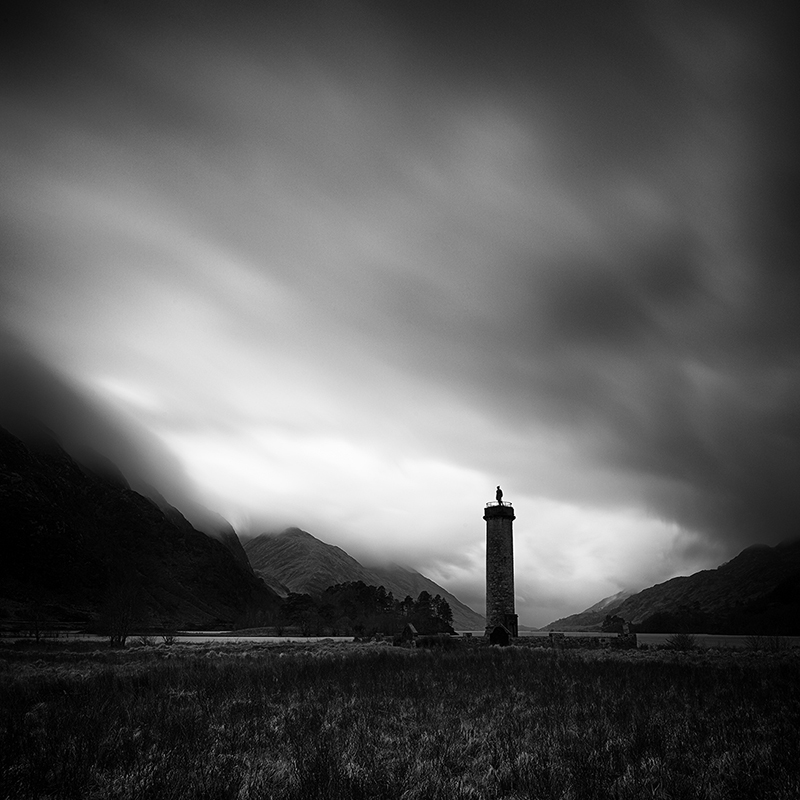
‘Gathering Storm’ (Glenfinnan Monument, Loch Shiel, Scotland)
Alpa TC, 36mm Schneider lens, Phase One P20+
This photograph was taken at Glenfinnan in the Scottish Highlands. It is close to the place where Bonnie Prince Charlie gathered the clans in 1745 before marching his troops into battle to stake his claim for the throne. The monument you see in the photo was erected in their memory. I’ve been there many times and had previously struggled to produce an image that captured the drama of the location. However on a trip there last year I was rewarded with the dark & threatening storm clouds you see here. It was raining and the sky & light constantly changing so I set up the camera and waited for the story to unfold in front of me. I framed the image to emphasise the sky and used ND filters with the intention of recording the movement of the clouds to convey a sense of power and dynamism. Eventually I got my shot as a result of my patience and persistence as well as a lucky coincidence of the historical context and the weather – hence my title, ‘Gathering Storm’.
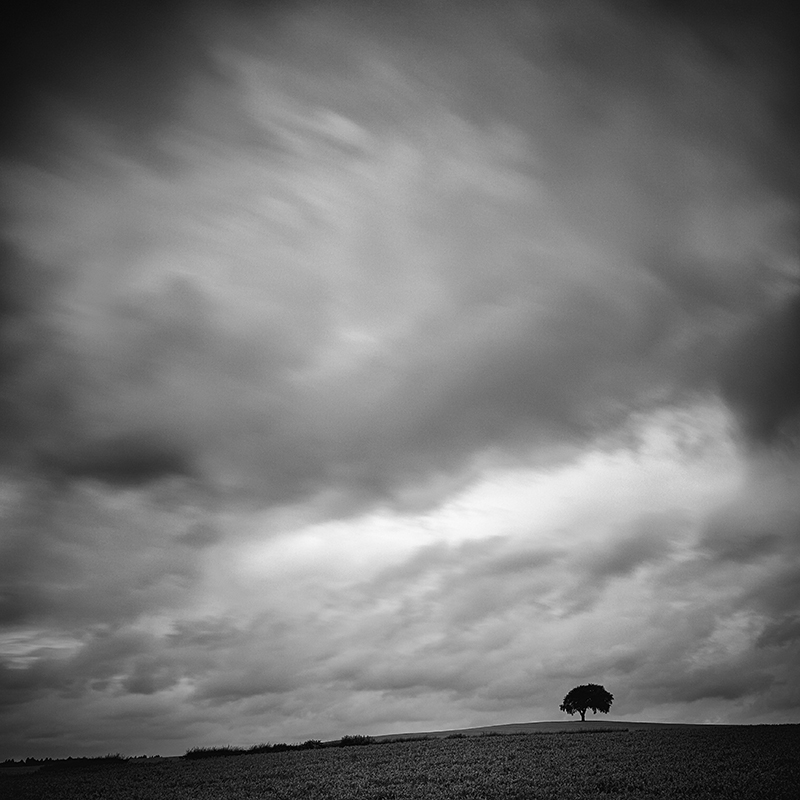
‘And the Heavens Opened’ (North Yorkshire, England)
Alpa TC, 36mm Schneider lens, Phase One P20+
This lone tree sits on a small hill quite close to where I live so it’s a location I return to on a regular basis. On this particular visit I was greeted by a fantastic sky – large, rain filled clouds, blown by the wind. Standing there, looking upwards I felt small and quite insignificant on the surface of the planet; completely dwarfed by the heavens. I composed the shot to place the tree small in the frame and positioned it close to the edge of the frame, as if being pushed out of the photograph by the sheer vastness of the sky. I used this simple compositional device to act as a visual simile for how I felt. Unexpectedly the clouds parted above the tree and the scene reminded me of a 1950s biblical inspired movie with Gods voice booming down out of the heavens!. Hence my title for it – ‘And the Heavens Opened’.
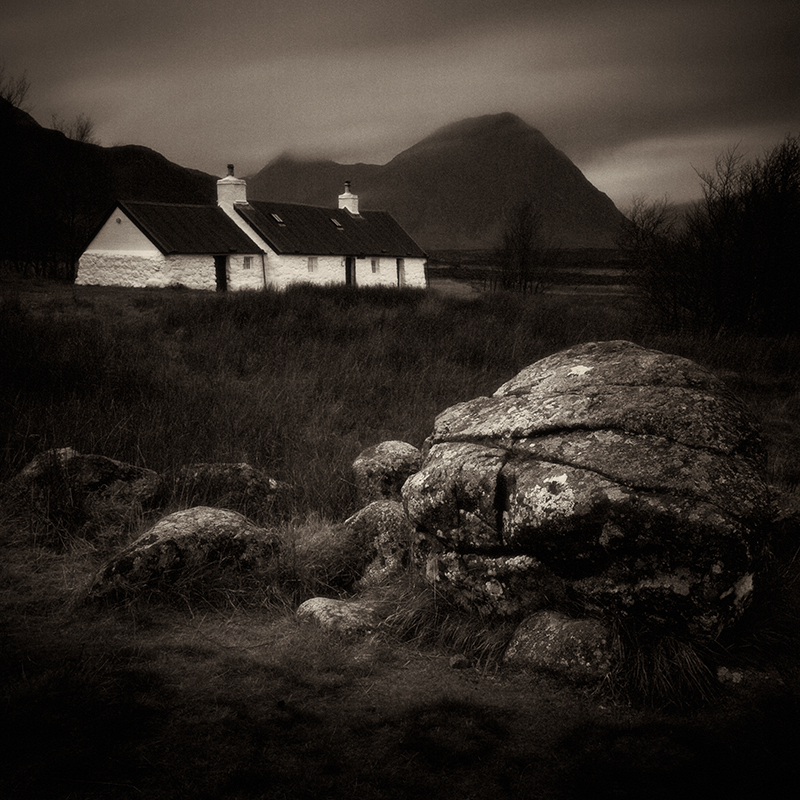
‘Dusk Descends’ (Black Rock Cottage, Glencoe, Scotland)
Hasselblad 903SWC (fixed 38mm lens), Phase one P20+
Another much photographed location with a bloody and historical past (as is true for a lot of the Scottish Highlands). This photograph was taken in Glencoe – the site of the famous massacre of the Clan MacDonald at the hands of Clan Campbell and the English in 1692. It can be an eerie and ghostly location from within which the spirits of the massacred seem to seep and permeate the air – particularly as night draws in.
This photograph was taken at dusk and the required long exposure (8 minutes) gave a lovely sense of movement to the sky. A higher ISO (800) than I’d normally use was selected in part to give me a manageable exposure time but also to create the ‘gritty’ texture that matches the nature of the location. The final image was also softened slightly at the processing stage to accentuate the mood I was trying to recreate and to enhance the gentle light illuminating the cottage and the foreground rock.
September, 2013
I opened this article with a quote and I’d like to close it with one – from British photographer Don McCullin (a guy best known for his war images) who said: –
“Photography for me is not looking, it’s feeling. If you can’t feel what you are looking at then you are never going to get others to feel anything when they look at your pictures”.
Steve is currently working on a book on this topic of photographing from the heart. If you’d like to register your interest in buying a copy please email Steve atsteve@stevegoslingphotography.co.uk
About the Photographer
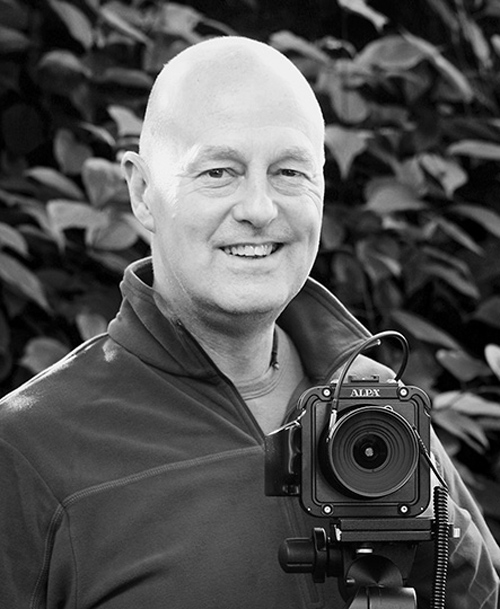
Steve is an award winning professional photographer who specialises in producing creative & contemporary landscape images (his signature style is moody & atmospheric black & white photographs). His photographs have been published internationally in books, magazines & newspapers and on greetings cards, posters & advertisements.
He particularly enjoys writing & teaching about photography. He frequently gives talks to photographic groups in the UK & abroad and is also a regular contributor to photography magazines in many different countries. He has run a successful workshop programme for several years as well as leading workshops on behalf of clients such as Phase One & Olympus, encouraging and inspiring photographers of all levels from across the world.
To see more of Steve Gosling’s images or to find out about his workshop programme visit his website –www.stevegoslingphotography.co.uk
Steve Gosling
E-mail:steve@stevegoslingphotography.co.uk
Mobile: +44(0)776 996 7933
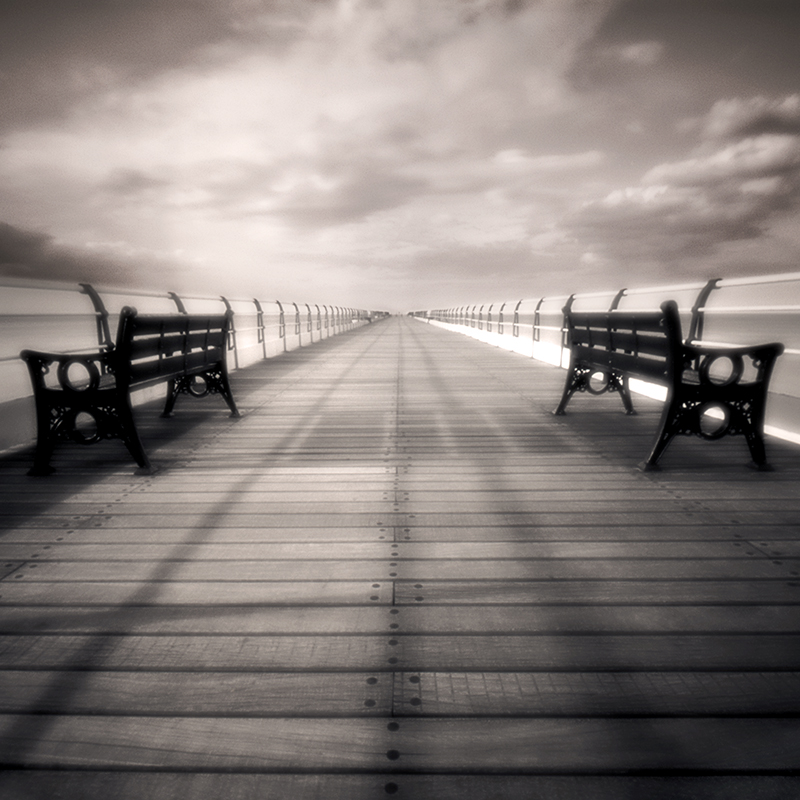
Lorem ipsum dolor sit amet, consectetur adipiscing elit, sed do eiusmod tempor incididunt ut labore et dolore magna aliqua. Ut enim ad minim veniam, quis nostrud exercitation ullamco laboris nisi ut aliquip ex ea commodo consequat. Duis aute irure dolor in reprehenderit in voluptate velit esse cillum dolore eu fugiat nulla pariatur. Excepteur sint occaecat cupidatat non proident, sunt in culpa qui officia deserunt mollit anim id est laborum.
Lorem ipsum dolor sit amet, consectetur adipiscing elit, sed do eiusmod tempor incididunt ut labore et dolore magna aliqua. Ut enim ad minim veniam, quis nostrud exercitation ullamco laboris nisi ut aliquip ex ea commodo consequat. Duis aute irure dolor in reprehenderit in voluptate velit esse cillum dolore eu fugiat nulla pariatur. Excepteur sint occaecat cupidatat non proident, sunt in culpa qui officia deserunt mollit anim id est laborum.
You May Also Enjoy...
HartbleiCam 24mm with 6mm rise
Please use your browser'sBACKbutton to return to the page that brought you here.
